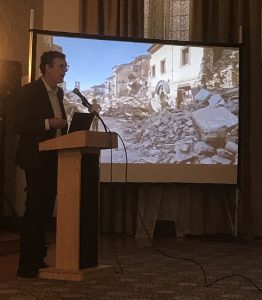Can There be a Cure for Catastrophe?
On Thursday March 2nd 2017 the Initiative on Extreme Weather and Climate hosted Dr. Robert Muir-Wood, the head of research at Risk Management Solutions (RMS) and a world-leading “catastrophe scientist” who presented “The Cure for Catastrophe – how we can stop manufacturing natural disasters,” based on his book by the same title.

Adam Sobel introducing Robert Muir-Wood
Opening with a story about a modern earthquake Amatrice, Italy known for many centuries to be earthquake-prone, Muir-Wood proposed a scientific approach to disasters. In such a place, earthquakes can no longer be seen as acts of God or of raw primal nature. “There is nothing surprising about earthquakes,” Dr. Muir-Wood emphasized, “The same earthquakes happened several hundred years ago.”
In 1980, Muir-Wood visited El Asnam, an Algerian city that had just been flattened by an earthquake. Two groups of individuals came to the site of the disaster: earthquake scientists and structural engineers. Earthquake scientists sought to learn more about the earthquakes themselves; Structural engineers sought to learn why the buildings fell. He observed that the key issue was being ignored: what can be done to ensure that buildings in the future are built to be as earthquake-proof as possible? Muir-Wood pointed out that “It’s not the earthquake that kills you, it’s the buildings.”
 The current American denialism around climate change has a clear but little-known historical precedent. Muir-Wood recounted that, after the catastrophic 1906 San Francisco earthquake, similar denial suppressed earthquake research and even seismic monitoring in the USA. A Bureau of Earthquakes was proposed in 1911, but shot down by Congress after lobbying from California interests who were afraid the state’s development might be hindered if it were perceived to have an “earthquake problem”. Only in 1925 did this earthquake denialism end and a push to construct more earthquake-resistant buildings begin.
The current American denialism around climate change has a clear but little-known historical precedent. Muir-Wood recounted that, after the catastrophic 1906 San Francisco earthquake, similar denial suppressed earthquake research and even seismic monitoring in the USA. A Bureau of Earthquakes was proposed in 1911, but shot down by Congress after lobbying from California interests who were afraid the state’s development might be hindered if it were perceived to have an “earthquake problem”. Only in 1925 did this earthquake denialism end and a push to construct more earthquake-resistant buildings begin.
Muir-Wood discussed the difficulties of living in regions prone to multiple hazards. Wooden buildings are more earthquake resistant than brick or stone, but also burn much more easily. In several examples of different cities throughout history, wooden buildings burned down in great fires, to be replaced with stone which, in turn, when struck by earthquakes, again caused mass destruction.
It is far more effect ive to invest money in disaster prevention than to pay for disaster relief afterwards, Muir-Wood emphasized, but the incentives for politicians in most countries nonetheless favor relief over prevention. He narrowed it down to two issues: disaster policy and disaster culture. Disaster policy is made by governments, and must be viewed through the lens of disaster risk modeling to see if there is progress being made, because truly large disasters are sufficiently infrequent that one cannot wait for them to happen in order to evaluate prevention efforts. Disaster culture is much more difficult to encourage, but manifests when normal citizens understand the natural hazards they face and are willing to take some responsibility for risk reduction – as opposed to denying the hazards’ existence, consciously or unconsciously. In two examples of tsunamis, 2004 in southeast Asia and 2011 in Japan, Muir-Wood gave anecdotes of schoolchildren saving the lives of themselves and others by taking the initiative to warn others quickly, without waiting for authorities, based on their own observations in the moment and lessons learned in school that enabled them to recognize the signs of the oncoming deluges.
ive to invest money in disaster prevention than to pay for disaster relief afterwards, Muir-Wood emphasized, but the incentives for politicians in most countries nonetheless favor relief over prevention. He narrowed it down to two issues: disaster policy and disaster culture. Disaster policy is made by governments, and must be viewed through the lens of disaster risk modeling to see if there is progress being made, because truly large disasters are sufficiently infrequent that one cannot wait for them to happen in order to evaluate prevention efforts. Disaster culture is much more difficult to encourage, but manifests when normal citizens understand the natural hazards they face and are willing to take some responsibility for risk reduction – as opposed to denying the hazards’ existence, consciously or unconsciously. In two examples of tsunamis, 2004 in southeast Asia and 2011 in Japan, Muir-Wood gave anecdotes of schoolchildren saving the lives of themselves and others by taking the initiative to warn others quickly, without waiting for authorities, based on their own observations in the moment and lessons learned in school that enabled them to recognize the signs of the oncoming deluges.
To the question: “Can there be a cure for catastrophe?” Muir-Wood answered, “Yes. But we need local disaster culture and callout. And to argue against denialism.”


Submit Comment